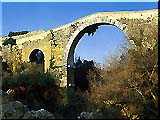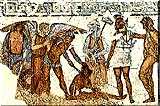|
The
heritage
The Etruscan city of Vulci (VelX- in Etruscan) lies on the
border between Lazio and Tuscany, about fifty miles north-west
of Rome. It stood close to the sea on the right bank of the
river Fiora, on a plateau of volcanic origin, in an area which
is today uninhabited. The National Museum is housed in the
Castle of La Badia, where finds from the excavations in the
city and necropolis are on display.
The
history
Vulci was famous in the ancient world for trade,
handicrafts and agriculture. Active from as early as the 8th
century BC, the city expanded its control over the surrounding
territory in the following two centuries. In the 6th century
BC, local handicrafts, strengthened by the presence of Greek
labour, gave rise to the production of ceramics, sculptures
and objects in bronze, of excellent workmanship, which reached
markets throughout the Mediterranean. After the crisis of
the 5th century BC, which did not seriously affect Vulci,
the recovery of the following century led to the construction
of new public works, such as the walls and the temple, discovered
in the urban area. In
the second half of the 4th century BC, Vulci began to feel
the weight of Roman expansionism. The struggle to remain independent
came to an end in 280 BC when, defeated, it had to relinquish
a large part of its territory, including the coast to Rome.
Once it had lost its independence, the city declined and rapidly
disappeared completely.
The
archaeological areas
The city
On
the site of the ancient city, it is possible to see the remains
of a villa dating from the 1st century BC, a long stretch
of a Roman road, the foundations of an Etruscan temple and
the remains of two doors in the city walls.
The
necropolises
Four
necropolises dating from the 8th century BC have been found
around the city of Vulci. The tombs of the 6th and 5th centuries
BC are generally of the sarcophagus type. Only a few graves
are an exception, including the large tumulus of the "cuccumella".
The habit of placing statues of imaginary animals to guard
the tombs is characteristic of Vulci. Immensely rich burial
treasures have been found in these tombs, in particular a
large number of ceramics of Greek production, and bronze objects
of local production. In the second half of the 4th century
BC, the tombs became of the hypogeal type and reproduce the
shapes of the dwellings. The most well-known of these hypogea
is the François tomb, famous for its paintings (now
at Villa Albani in Rome) portraying, as well as the deceased,
episodes from Greek mythology together with characters from
Etruscan myths.
|




